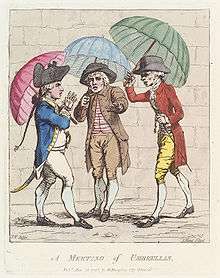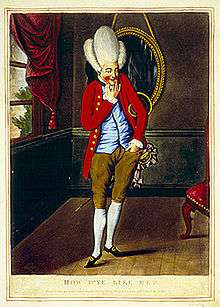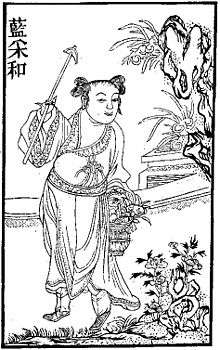
Adult male carrying an umbrella for himself in an English city or town had the connotations of excessive dandyism or effeminacy in the eighteenth century
Effeminacy describes traits in a human male that are more often associated with feminine nature, behavior, mannerisms, style or gender roles rather than masculine nature, behaviour, mannerisms, style or roles. The term effeminate is most often used by people who subscribe to the widespread view that males should display masculine traits and behaviours. Generally, the description is applied to individuals, but may be used to describe entire societies as an inflammatory allegation.
Quotes
- In a slothfull peace both courages will effeminate, and manners corrupt.
- Francis Bacon, in Bacon's essays, CUP Archive.
- Know ye not that the unrighteous shall not inherit the kingdom of God? Be not deceived: neither fornicators, nor idolaters, nor adulterers, nor effeminate, nor abusers of themselves with mankind, nor thieves, nor covetous, nor drunkards, nor revilers, nor extortioners, shall inherit the kingdom of God.
- Bible, in The New Testament Greek and English, CUP Archive, 1970, p. 712
- Many Scottish writers [however] against the background of the Napoleonic wars, began to disparage this characteristic, and imputed effeminacy to Hinduism, conceptualizing the difference between effeminate Hindus and valiant (and virtuous) Muslims.
- Jeng-Guo S. Chen, in Gendering India: Effeminacy and the Scottish Enlightenment's Debates over Virtue and Luxury, Project Muse,
- I'm all for guys being butch and guys being men. I identify with that and appreciate that. But if I'm going to stab my gay brother in the back who isn't butch and who maybe acts a little bit more effeminate, what good is that?
- Kyan Douglas, in The Advocate, Here Publishing, 2 September 2003, p. 44
- Effeminacy comes from the Latin ex which is "out," and femina which means woman; it means "to be like a woman." The Latin term is mollities, meaning "softness”.
- Heinz Duthel, in Kathoey Ladyboy, BoD – Books on Demand, 2013, p. 39
- The masculine virtues of Rome were mirrored by the literal emasculation of a cadre of eunuchs in its political and social decline, as the use and value of those effeminate slaves gradually rose with the decline of the empire. Eunuchs were a final luxuriant import from the reign of Elagabalus, when Rome was at length humbled beneath the effeminate luxury of Oriental despotism.
- Edward Gibbon, in "Decline and Fall of the Roman Empire (1776)", in Jean Howard, et al Luxurious Sexualities: Textual Practice Volume 11, Issue 3, Routledge, 12 August 2005, p. 130
- ...the effeminacy of the inhabitants of Bengal not only became more widespread and virulent, but also acquired a more specific meaning in the late nineteenth century sterotype of the ‘effeminate Bengali babu.’ If in the past effeminacy loosely characterized all the inhabitants of Bengal, in the second half of the century it was used quite specifically to characterize the Indian middle class, or a section of this class identified as babus. In Bengal itself, therefore, effeminacy came to be associated with a small percentage of the total population.
- Lord Maculey, in Mrinalini Sinha, Colonial Masculinity: The 'manly Englishman' and The' Effeminate Bengali' in the Late Nineteenth Century, Manchester University Press, 1 January 1995, p. 16
- Judgement of what constitutes ‘effeminacy’ will, of course, be shaped by his or her culturally established views on gender roles. And, as is true for beauty, while one’s notions of masculinity and femininity may be culturally proscribed, ultimately any judgement as to what is beautiful or what is effeminate will be made on the basis of not only one’s surrounding culture or cultures but, subjectively, on the basis of complex internal factors, both conscious and unconscious.
- Roald Maliangkay, in The effeminacy of male beauty in Korea, Australian National University.

Coloured engraving of a Macaroni or Molly, an 18th Century term for effeminate homosexual -Karl Philipp Moritz: It is a common observation, that the more solicitous any people are about dress, the more effeminate they are.
- In Korea, where beautiful male pop icons are now commonly referred to as kkonminam (kkot= flower; minam= handsome man), Korean male beauty has, by any standard of judgement, taken on a distinctly effeminate quality.
- Roald Maliangkay, in “The effeminacy of male beauty in Korea”.
- Today’s young woman is very unlikely to be looking for a man who is as effeminate as she, or whose sexual orientation is in question.
- Roald Maliangkay, in “The effeminacy of male beauty in Korea”.
- People don't know where to place me. Terry Gilliam used me as a quirky cop in 'Twelve Monkeys', and then he hired me again to be an effeminate hotel clerk in 'Fear and Loathing in Las Vegas'. Another time, I was shooting this indie film 'The Souler Opposite' and six days a week, I'm playing this big puppy dog, then I come to the 'NYPD Blue' set and become this scumbag.
- It is a common observation, that the more solicitous any people are about dress, the more effeminate they are.
- Karl Philipp Moritz, in John Pinkerton A General Collection of the Best and Most Interesting Voyages and ..., Volume 2, Longman, 1808, p. 518
- An effeminate education weakens both the mind and the body.
- Edgar Quinet, in Quotes about Education, Quotations Book

Christopher Ransom:Actualised or hypothetical effeminacy is constructed in the Iliad in order to define, by contrast, a ‘proper’ masculinity, founded on concepts of martial fortitude and civic responsibility, thoroughly antithetical to the ‘other’ which the effeminised male symbolizes.
- Actualised or hypothetical effeminacy is constructed in the Iliad in order to define, by contrast, a ‘proper’ masculinity, founded on concepts of martial fortitude and civic responsibility, thoroughly antithetical to the ‘other’ which the effeminised male symbolizes.
- Christopher Rawsom, in Aspects of Effeminacy and Masculinity in the Iliad, The University of Sydney, Antichthon 45 (2011), p. 35
- A Iliad poem
Αh me! You boasters, you women, no longer men, of Achaia! Indeed this will be a matter for reproach, and shameful above all shame,if none of the Danaans will now go face to face against Hektor.- Christopher Rawsom, states that in this, poem rebukes and exhortations which lay charges of male effeminacy, or in some way involve a counterpoint between the masculineand the feminine., in “Aspects of Effeminacy and Masculinity in the Iliad”, p. 36
- ... the concept of effeminacy is employed throughout the Iliad in order to create an ‘other’ against which epic masculinity can be defined. Although the presentation of the effeminised male (hypothetical oractual) is often ambiguous and multifaceted, an examination of effeminacy and masculine ‘otherness’, within the context of the gender dynamics of the epic, has important implications for an understanding of the construction of masculinity.
- Christopher Rawsom, in “Aspects of Effeminacy and Masculinity in the Iliad”, p. 57
- There is a definite prejudice towards men who use femininity as part of their palate; their emotional palate, their physical palate. Is that changing? It’s changing in ways that don’t advance the cause of femininity. I’m not talking frilly-laced pink things or Hello Kitty stuff. I’m talking about goddess energy, intuition and feelings. That is still under attack, and it has gotten worse.
- RuPaul, in RuPaul speaks about society and the state of drag as performance art, Wikinews, 6 October 2007.
- The avoidance of effeminacy by men, including gay ones, has been linked to possible impedence of personal and public health. Regarding AIDS, masculine behavior was stereotyped as being unconcerned about safe sex practices while engaging in promiscuous behavior. Earlier reports had reported from New York City indicated that that more women had themselves tested for AIDS than men.
- Sullivan (1987), in Kathoey Ladyboy, p. 39
- A lot of kids are bullied because of their sexual identity or expression. It's often the effeminate boys and the masculine girls, the ones who violate gender norms and expectations, who get bullied.
- Dan Savage, in Sierra Tishgart Dan Savage Explores College Relationships on his New MTV Show, Teen Vogue
- Men do indeed speak ill of those occupations which are called handicrafts, and they are rightly held of little repute in communities, because they weaken the bodies of those who make their living at them by compelling them to sit and pass their days indoors. Some indeed work all the time by a fire. But when the body becomes effeminate (thelunomenos) the mind too is debilitated. Besides, these mechanical occupations (banausos) leave a man no leisure to attend to his friends' interests, or the public interest. This class therefore cannot be of much use to his friends or defend his country. Indeed, some states, especially the most warlike, do not allow a citizen to engage in these handicraft occupations.
- Socrates. The Greek idea that those engaged in mechanical trades incurred effeminacy was expressed by Xenophon, in Humphrey Davy Findley Kitto, in The Greeks, Transaction Publishers, 1968, p. 240

Ancient woodcut of Lain Caihe, one of the Eight Immortals of Chinese mythology. His sex and age are unknown. He is usually portrayed as an effeminate boy or as a hermaphrodite.
- Those who are born of parents broken with old age, or of such as are not yet ripe or are too young, or of drunkards, soft or effeminate men, want a great and liberal ingenuity or wit.
- The female body played an important role in signaling effeminacy; effeminate sensuality could be expressed either through consorting with woman or imitating them through adopting traditionally feminine modes of dress or appearance. Although largely used to describe men effeminacy, interestingly enough, could also apply to women who did not live to an expected standard of feminity. Given its range of meanings effeminacy, by the mid eighteenth century acted as a “civilization’s barometer".
- Effeminacy is especially germane to someone like myself, a man who falls on the other side of (so-called) masculine demeanor. In other words, effeminate. What was always strange is that I never truly understood what it meant. Growing up, I did not realize my mannerisms were even feminine. I was merely me; my outsized "femininity" was innate. To me, I was simply myself.
External links
This article is issued from
Wikiquote.
The text is licensed under Creative
Commons - Attribution - Sharealike.
Additional terms may apply for the media files.
